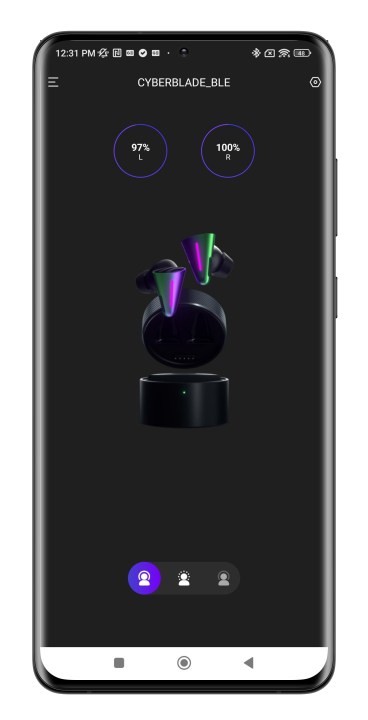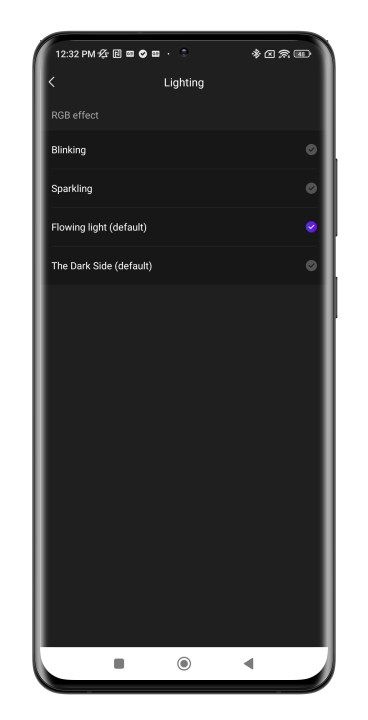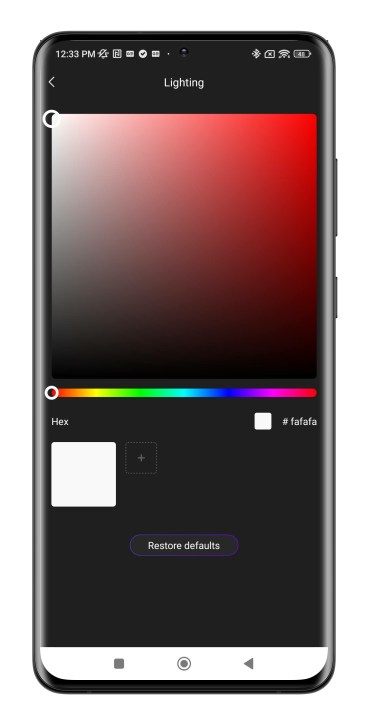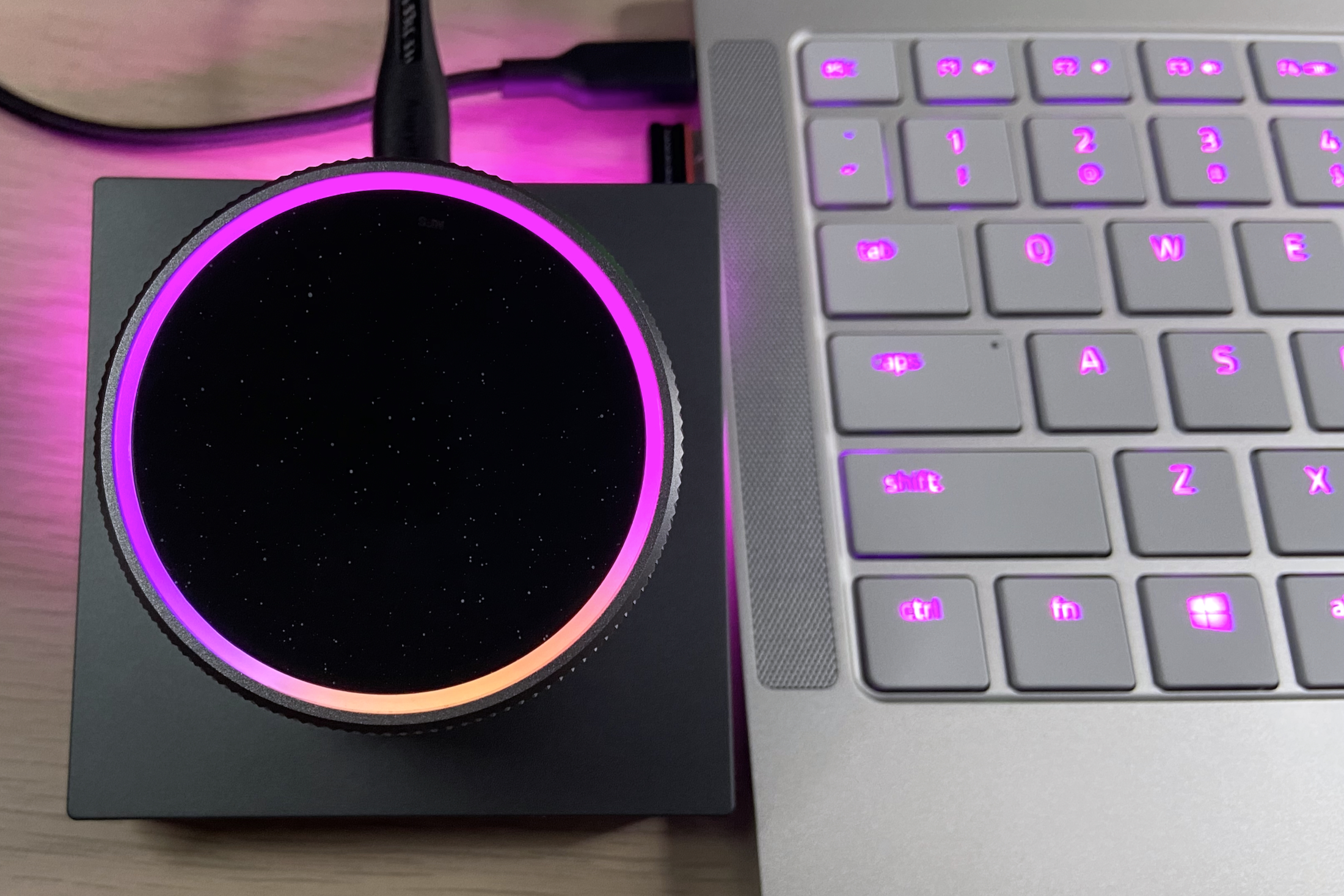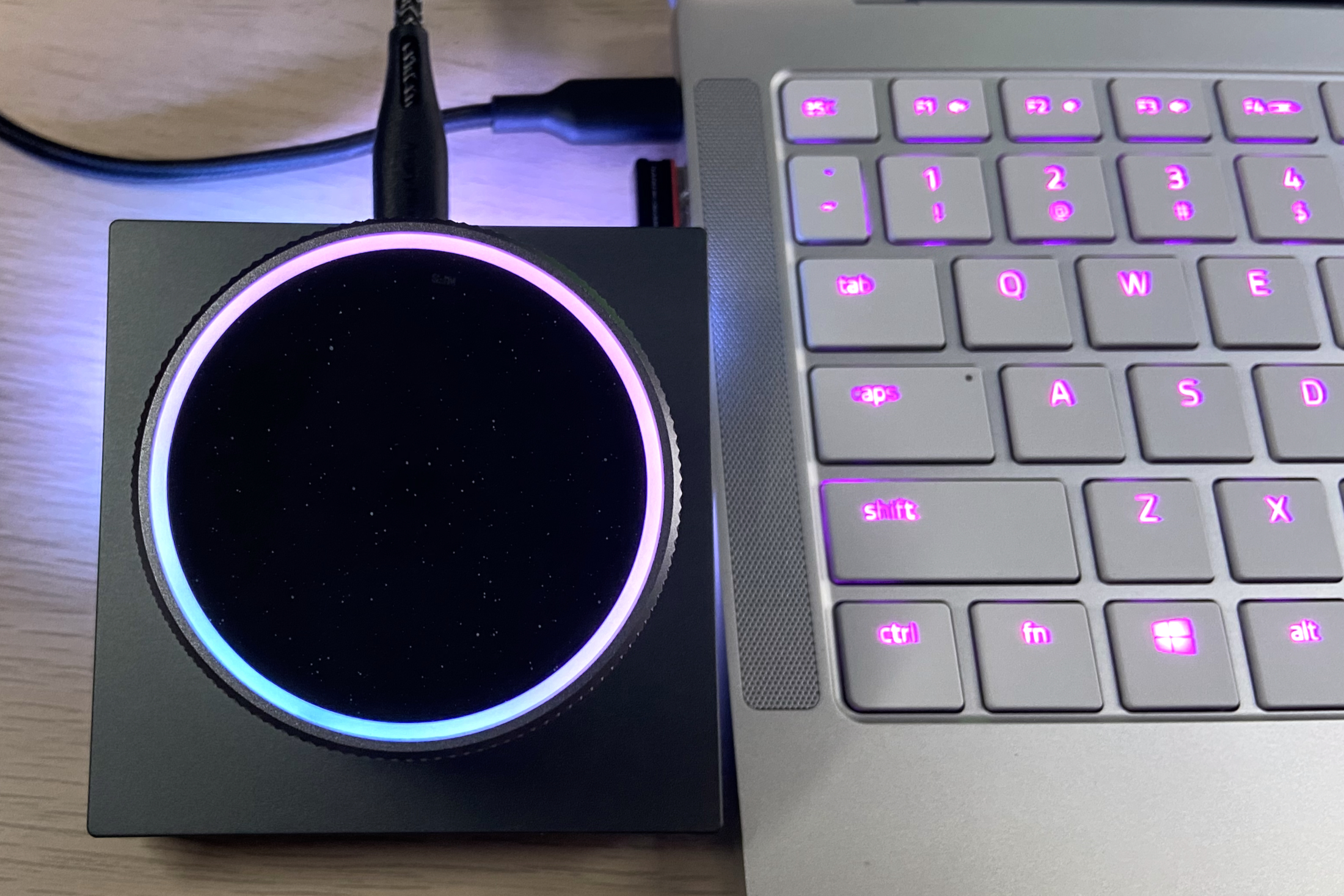“Angry Miao's Cyberblade wireless earbuds are so beautifully designed that even non-gamers will want them.”
- Gorgeous design
- Ultra low latency
- Great sound quality
- Very good ANC/transparency
- Very good voice quality
- Limited in-app EQ settings
- No control customization
- Charging case poorly suited for travel
- May not satisfy hardcore gamers
I’m not much of a gamer, but I am a big fan of wireless earbuds. So when a company called Angry Miao reached out to me to see if I’d like to review its new gaming-oriented wireless earbuds, how could I say no? I mean, c’mon, with a name like Angry Miao Cyberblade, I had to check them out. Angry Miao is currently drumming up support for the Cyberblade via a Kickstarter campaign with an early-bird price of $300, and the company will start selling them via its website later in 2022, for $328.
I might not know my Half-Life from my Halo, but Digital Trends’ resident PC and gaming hardware maestro, Jacob Roach, sure does. So we teamed up and put the angriest earbuds ever made to the test, to see (and hear) what they’re all about.
What’s in the box?

First, I need to express my admiration for the box itself. Angry Miao has packaged the Cyberblades as though they were a collector’s item, and in some ways they are. Pull off the box top and remove the top protective layer of foam and you’ll find all of the components laid out in their own individual compartments.
You get two types of braided USB cable — a shorter USB-C to USB-C, and a longer USB-A to USB-C, which makes sense as the USB-A version is probably going to be used by those with desktop computers and the shorter one by those with laptops.
Then there’s a magnetic charging base, the earbuds’ charging case (with the Cyberblades already inside), a very comprehensive owners manual, and seven additional types and sizes of eartips (three memory foam and a total of five silicone tips when you include the preinstalled ones). With the exception of the protective foam layer, the whole package could be recycled if you wanted, but I suspect most buyers will hold onto it.
Why ‘gaming earbuds?’
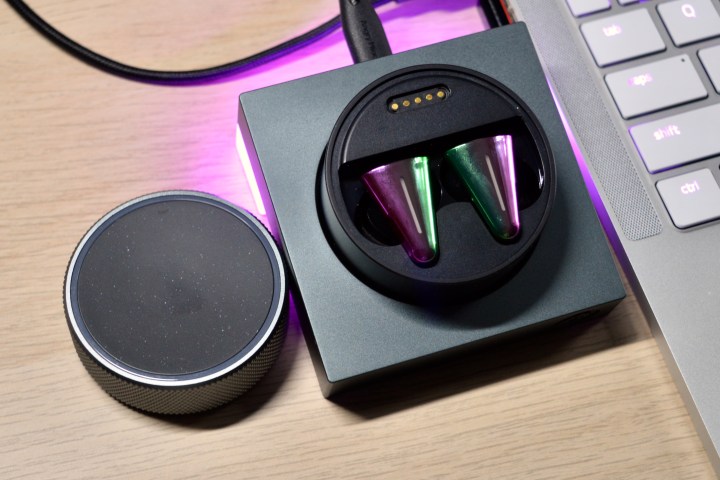
What makes a set of wireless earbuds a set of gaming wireless earbuds? For those who don’t already know, it’s all about latency. Normal Bluetooth connections introduce quite a bit of lag time (anywhere from 100 milliseconds to 400 milliseconds) between when a sound is generated by a game and when it is finally turned into a sound your ears can hear.
You can get these wireless connections to run as low as 40 milliseconds, but your source device (PC or console) and your earbuds need to support a codec like Qualcomm’s aptX LL. And since Bluetooth audio is nonexistent even on the PS5 and Xbox Series X, and PCs that do have Bluetooth usually don’t support aptX LL, you need to do some serious homework to get a solution that works.
The Cyberblade effectively are a one-stop shop for low latency. The key, I’m told, is that Angry Miao has embedded an additional chip inside the charging case. When the case is connected to a computer or console via one of the USB cables, that chip can create a wireless pathway to the chips in each Cyberblade earbud that runs at a very fast 36 milliseconds of latency. The company calls it the “Superfast” connection, which is one aspect of a technology Angry Miao calls Active Sound Enhancement (ASE). Yeah, that’s a lot of branding, so we’ll break it down later into actual experiences.
The important thing here is that there’s no need to worry about whether your source device and earbuds have the right codecs — it’s all contained within the Cyberblade’s components.
Latency might be the biggest factor for gamers, but it’s far from the only one. Comfort, microphone quality, sound quality, and convenience features matter too. And since those things matter to non-gamers as well, a great set of gaming earbuds could end up being a great set of earbuds, period.
Design

What distinguishes the Cyberblades from all other wireless earbuds isn’t just their low latency — it’s their entire design. They’re like no other earbuds I’ve ever seen.
Their charging case is way more than a place to house and juice up the buds when they’re not in use. It also doubles as a beautifully crafted PC accessory for volume control, microphone muting, and sound mode. The key ingredient is its magnetically latching lid, which is also a rotating dial with push-button functionality. Embedded in its top surface is an LED light ring that not only looks stunning, but it’s also practical: each color pattern (some that animate, some that don’t) represents status information for charging, microphone muting, and sound mode.

All of these features work when the case is plugged into a PC (or a Mac), but if you use the case alone, it might shift and slide around on your desktop. That’s presumably why the Cyberblade was designed with an angled, magnetic base. It’s weighty, solid, has a set of rubber feet, and has its own LED lighting system that is visible through the transparent acrylic beam at the back.
When you plug the USB cable into the back of the base instead of the case, those LED lights match the color and animation style of the case lid, and the base can pass power and data seamlessly to the case.
When placed together, the base and case look and feel just like a jog controller from a professional video-editing suite. The magnetic links between the lid, the case, and the base let each component snap precisely into place, but you may need to rotate them a bit to ensure the electrical contacts line up.

My only critique is that the lid magnets are much stronger than the ones connecting the case and the base, so when you want to remove or replace the earbuds, you need to hold the case with one hand while you remove the lid with the other. The base magnets just aren’t powerful enough to do this move one-handed and you’ll pull the case right off the base if you do. The top of the case lid also tends to show your fingerprint oils over time.
By the way, the case can also charge wirelessly on any Qi-compatible charging mat, so you don’t need to haul around the base if you’re traveling. On the other hand, the case is so big, it won’t fit in a pocket. It’s also such a fundamental part of the Cybeblade experience that I’d be worried about damaging it by sticking it in a purse or backpack. It could really do with its own protective travel case.

There are three color options for the Cyberblade: Shell Black (a glossy fingerprint-magnet iridescent/translucent set of earbuds with a gray/black case and base), Ghost White (matte white earbuds, white/silver case and base), and The Dark Side, a fully blacked-out color scheme. In the accompanying photos, you can see the Shell Black and Ghost White versions.
Though identical in features, there’s one important difference between these options. Ghost White and The Dark Side have case lids with smoothly finished aluminum, but the Shell Black edition gets a knurled finish that provides a lot more grip. Both are gorgeous, but I adore the knurled dial of the Shell Black model.
The Cyberblade earbuds tell their own unique design story. Angry Miao says it took inspiration from the game Horizon Zero Dawn, which led to the triangular shape and integrated LED light strip. Speaking of that LED light, I know you’re wondering: can it be customized or turned off? Yes. The available Android app (to be followed by an iOS app) lets you switch between two preset LED light displays (Flowing Light and The Dark Side), and two customizable displays (Blinking and Sparkling) which can be color-edited right in the app. You can turn off the LED completely using the earbud touch controls.
When you’re not using the Cyberblades via the wired/Superfast connection, they work like any other set of Bluetooth earbuds, able to pair with your choice of smartphone, with both AAC and SBC codec support. And though they shouldn’t be considered waterproof, with an IPX4 rating, they should have no problem with a bit of rain or sweat as long as you wipe and dry them afterward.
Comfort, controls, and connections
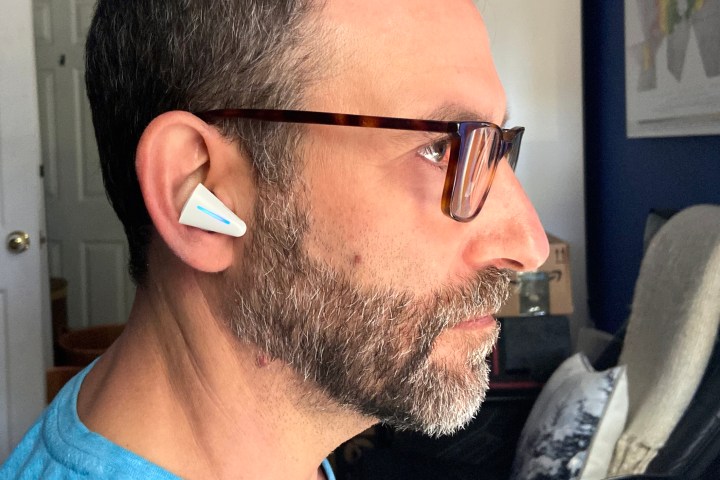
The part of the Cyberblades that sits inside your ear is shaped just like the AirPods Pro. And despite their larger exterior, they only weigh 6.5 grams, which is to say, they’re very comfortable even for extended periods. But gamers often push these boundaries farther than most earbud users — up to 5.1 hours in an average binge gaming session according to at least one study.
If that’s the kind of gaming you like to do, I’m not sure any earbuds will remain comfortable enough to keep you going. Be sure to check out the abundance of eartips in the box — not only will they give you a huge variety of fit options, but they’ll help you get better bass and ANC performance when you find ones that create a really good seal.
The charging case’s rotating lid has a gentle notchiness as it spins, which feels great and reinforces that studio-quality vibe. It’s perfect for controlling volume, but I guarantee you’ll find yourself spinning at other times too, just because it’s so fun to do so. It’s also a giant button, that has a very distinct click mechanism. It takes a bit of pressure to push it, but that’s probably a good thing.
When in Superfast mode, a single click mutes or unmutes your mics (the LED ring goes solid red to remind you when you’re on mute), a long-press switches between the three available sound modes (more on them in a sec), and a double-click switches the earbuds from Superfast mode to standard Bluetooth mode. If you’ve already paired the Cyberblades to your phone, they immediately reconnect (or to whichever device they were last connected to). A single click when in Bluetooth mode returns you to Superfast mode.
So while the Cyberblades may not officially support Bluetooth Multipoint, this fast device switching is the next best thing and works similarly to Apple’s version of iCloud-based audio switching.

For the earbuds, Angy Miao once again looked to the AirPods Pro for their control inspiration. Each triangular stem has a flat section on the front edge that is used for squeeze gestures. You know you’ve squeezed correctly because you’ll hear an actual mechanical click. With single-, double-, triple-, and long-squeeze gestures, you can control play/pause, track skip forward/back, ANC mode change, and call answer/end, as well as switch the LEDs on and off.
Not having a volume adjustment is a bit of an inconvenience, but some people might be more frustrated by the lack of voice assistant access.
There’s also no way to customize any of these gestures in the app, but at least the presence of an app means that Angry Miao can issue firmware updates over time and might, if it can, add these features later. There’s also no way to defeat the built-in wear sensors, which auto-pause and resume your audio when you remove and replace the earbuds.
When in Bluetooth mode, the buds use Bluetooth 5.2. I found them easy to pair with both iOS and Android devices, and the connection remained strong up to about 20 feet indoors. In Superfast mode, that distance was a bit shorter — around 10 feet.
Sound quality and latency
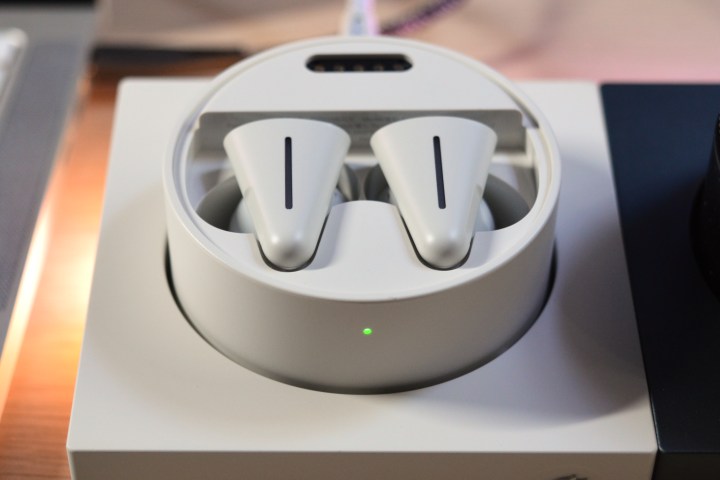
Music and movies sound fantastic on the Cyberblades. It’s a really rich and full sonic experience with a big dynamic range across all of the frequencies, particularly in the low-end where you can really feel the bass. It might not have the kind of ultra-precise detail audiophiles are in search of — there are better wireless earbuds for that — but they make up for that with a soundstage that is highly immersive; one might almost call it cinematic.
The highs are very clear if not quite crystalline, and the midtones are very satisfying. If the factory EQ isn’t to your liking, you can make two kinds of tweaks: the Android app lets you pick from three EQ presets (soft, vocal, and bass) — these stay with the earbuds regardless of your connection mode. But in Superfast mode, you can also choose from three sound modes (gaming, movie, and music). These modes are part of that ASE system I mentioned earlier and are the product of some sophisticated digital signal processing (DSP), and not just mere tweaks to the audible frequencies.
Angry Miao says that movie mode provides a virtual 7.1-channel surround sound presentation, music mode delivers “studio-level” EQ, and gaming mode is meant to improve your spatial awareness of footsteps and gunshots while performing as little processing as possible to keep that all-important low latency.
Each mode definitely sounds quite different from the other, and in truth, you might prefer one for your chosen listening activity even if it’s not the mode Angry Miao recommends. I enjoyed listening to music in both movie and music mode, for instance. The biggest difference is that movie mode offered a more expansive sound stage (and was absolutely the best mode for watching movies), while music mode made things tighter and clearer, with less low-end bass.
Here’s Jacob Roach’s take on using the Cyberblade buds for gaming, using gaming mode:
“The Cyberblade earbuds are great for gaming, but they expose why traditional over-ear gaming headsets are still the preferred way to play. The spatial sound in games like Destiny 2 is great, and there’s plenty of fine detail in the high-end to identify things like footsteps and gunshots from a distance. The main difference is that you don’t have that little sonic bubble around your ears that gaming headsets provide, so you don’t get the same level of immersion that you would get with a traditional gaming headset.
“I’m reaching for the SteelSeries Arctis Nova Pros if I want full detail, but the Cyberblades are still a good option, especially if you play games where hearing a pin drop doesn’t matter as much. In a game like Doom Eternal, for example, the Cyberblades sound great. But in Halo Infinite multiplayer where sound placement and small details make the difference, I wouldn’t bring out Angry Miao’s earbuds.
“That’s the duality between gaming earbuds and headsets right now as a whole. For the Cyberblades specifically, latency makes the difference. I couldn’t tell the difference between the low-latency gaming mode and the 2.4GHz connection on the Arctis Nova Pros in Metal: Hellsinger, which is a rhythm game that’s particularly punishing to audio latency.”
Noise cancellation and transparency

The Cyberblades have no problem silencing unwelcome background sounds. Whether you need to concentrate on in-game sounds, or you just need a break from all the chatter in your office, home, or local coffee shop, the ANC function makes a big difference. It’s not quite as good as what you’ll find on the Bose QuietComfort Earbuds, but considering the Cyberblades’ mission as a set of gaming earbuds, I don’t think that’s going to be a deal-breaker for most folks.
Transparency mode is very good and lets in a lot of external sound. Almost too much — Angry Miao is clearly using some amplification to let you hear what’s going on, and at times I wanted to tone it down, but there’s no way to do so.
Still, it’s easy to switch between ANC and transparency with a long squeeze of the earbud stems, and if you want to turn both off, you can do so in the app.
Call and voice quality
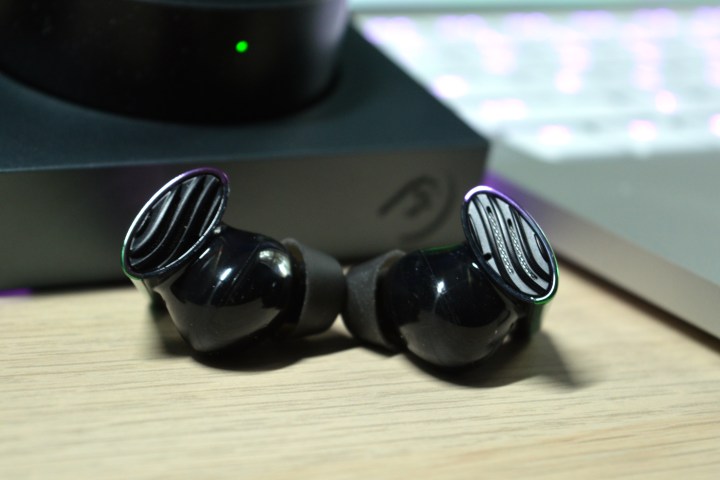
Whether you’re taking calls on your phone or using the Cyberblades for in-game voice, you’ll be heard loud and clear. I was expecting very good indoor performance from these buds, which they certainly deliver, but I was surprised how well they work in busy, outdoor environments too.
Even with the sound of traffic right beside me as I walked down the street, the Cyberblades did a very good job of minimizing that noise and keeping my voice from getting compressed or drowned out, something that even expensive wireless earbuds have been known to fail at.
Battery life
Remember earlier when I was discussing how long some gamers binge-play? The Cyberblades seem to be built with exactly that kind of usage in mind, with a claimed six hours per charge and about 24 hours in total when you include their charging case.
In my testing, that’s more or less right on the money as long as you keep volume no higher than 50%. Crank it up higher — say, 65% to 70% and you can expect that to drop to about five hours.
Unfortunately, there’s no fast-charge option, so if your buds are dead, they’ll take about 1.5 hours to fully charge.
As a set of gaming-oriented noise-canceling wireless earbuds, the Cyberblades are an unequivocal success. They sound great, they have an industrial design that is both stunning to look at and very well-thought-out. Yhey achieve a sub-40 millisecond latency that puts them close enough to a dedicated wireless headset that most gamers won’t notice any difference. With ANC, transparency, and voice quality that is near the top of what you’ll get from the likes of Sony, Bose, and Apple, they even perform surprisingly well as non-dedicated computer earbuds.
The real question isn’t whether the Cyberblades are worth it — like Angry Miao’s $700 keyboard, I think they justify their premium price quite easily — it’s whether wireless earbuds make sense for gaming in the first place. If you’re willing to give them a go and keep in mind Jacob’s cautions, they will reward you with a truly unique wireless earbud experience.
Just don’t forget that if you choose to back the Cybeblade via Kickstarter, the usual caveats and warnings apply.


